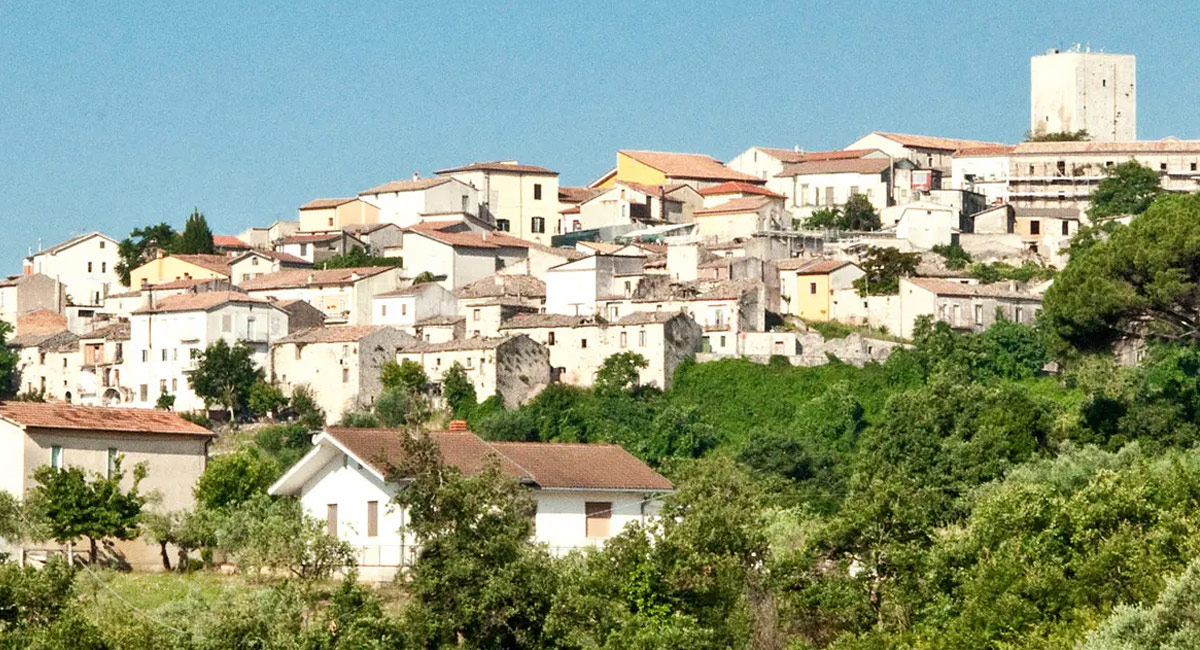ITINERARIES IN THE VALLEYS OF GOOD LIVINGCasalbore

Casalbore, whose name derives from Casali Albuli, a reference to the local white stone used in construction, lies on the border with the province of Benevento, along the Pescasseroli-Candela Royal Tratturo. The area has been inhabited since ancient times, as evidenced by the precious archaeological finds of the Tempio Italico (5th-6th century BC), the only known Samnite temple building in Irpinia, and the remains of the Samnite necropolis located in Spineto. In the Middle Ages, the village developed around the Norman Tower, the central nucleus of the defensive system that subsequently expanded. The Norman Tower is the historical and architectural symbol of Casalbore and, with its construction, likely marked the actual birth of the ancient village. Built at the beginning of the 13th century, the tower represented both an observation point, necessary for monitoring commercial traffic to and from Puglia, and a strategic bulwark placed to defend the Miscano Valley below. Only later did a more complex architectural complex, defended by bastions, develop around it. The entire complex, characteristically light gray in color, is built from the typical local stone. The tetragonal tower also serves as a vehicle access gate to the entire structure, which developed around a parade ground. A smaller tower, located to the southeast of the contemporary wall, also remains of the original fortress. Built in the Gothic style, as evidenced by some pointed arches and mullioned windows, the structure was transformed in the 16th century by the noble Caracciolo family, with the addition of four access gates and a hatch. To the west is the Porta Beneventana with a drawbridge, to the east the Porta Vallone, to the south the Porta Fontana, to the north the Porta Carrara for the passage of carts, and to the southeast the Portella (now Via G. Maraviglia). The interior of the Castle was divided into two courtyards, in one of which (located to the east) was located the popular seat for the judgements of the Marquis Court. The historic center also features several stately buildings, embellished with stone portals and Gothic-inspired windows. Among the religious buildings, the Monastery of Santa Maria della Misericordia stands out. Rebuilt after the 1962 earthquake, it houses a precious 18th-century canvas depicting the Madonna della Misericordia between Saint Dominic and other saints. The Church of Santa Maria dei Bossi, dating back to the early Middle Ages, was built using the walls of a funerary monument dating back to the 2nd century AD. Casalbore is also known as "the town of fifty springs" for the abundance of water sources in its lush green surroundings. It is renowned for its traditional products, particularly caciocavallo and Pecorino di Laticauda cheeses, made with the milk of sheep that represent a valuable local biodiversity. It is also renowned for its Marche meats and cured meats made from locally raised pigs.
ITINERARIES IN THE VALLEYS OF GOOD LIVINGPlaces of Interest
Norman Tower – Castle Museum
The Norman Tower served as a strategic defense and observation point for monitoring trade in the Miscano Valley; its construction likely marked the birth of the ancient village of Casalbore. A more complex architectural complex developed around it in later periods, defended by bastions and characterized by the light gray color of the typical local stone used in its construction. The structure is arranged around a large parade ground accessed through the so-called Porta Beneventana, carved into the lower part of the tower. This gate was probably not originally present, as similar towers typically had a water cistern on the ground floor and multiple floors divided by wooden floors. This hypothesis is further supported by the discovery of a moat at the base of the tower, which would also have been spanned by a drawbridge. The tower also featured a fireplace on the first floor and restrooms built into the walls on the upper levels. In addition to the aforementioned parade ground, a smaller tower to the southeast also remains of the original fortress that developed around the tower. In the 16th century, the Caracciolo family transformed the structure into a stately home, adding the palazzo on the southern side of the courtyard and three additional entrance gates. The buildings flanking the Norman Tower house the "Museo dei Castelli," a permanent exhibition and educational trail. The core of the exhibition is the photography exhibition "Images as Travel Notes: Castles and Fortifications in the Province of Avellino," which has been shown in several Italian cities, including Naples, Rome, and Bari, and has been highly acclaimed by critics, the press, and the public.
Italic temple
It stands near a spring, immediately downstream from the sheep track, in a locality called Macchia Porcara, a short distance from the Town Hall. Archaeological investigations that unearthed this ancient Samnite sanctuary attribute it to the cult of female deities, personifications of seismic or volcanic forces. The votive offerings discovered and the presence of spring water suggest that the deity worshipped was Mephitis, the goddess of fertility and reproduction, death and the underworld. Her cult was likely also linked to the practices of transhumance, considering that some of the sacred areas dedicated to her were mostly located along its path. The archaeological find dates back to the 3rd century BC, erected on a pre-existing primitive 4th-century BC shrine decorated with architectural terracottas of the Campanian style. Adjoining the sanctuary was a temple of Etruscan-Italic design, prostyle and hexastyle (i.e., with six columns placed only on the façade). The temple's quadrangular cella housed the cult statue, entered by a flight of steps that enclosed two fountains, fed by lead pipes. The complex was preceded by an open space with the sacrificial altar, flanked by a portico. The cocciopesto floor, decorated with diamond-shaped motifs in limestone tesserae, is of great value. The walls were plastered with a decoration of false ashlars painted in red and yellow, of the type known as the "first style," widely used in frescoes in Pompeian houses. From the finds, we learn that the temple's external terracotta decoration was perhaps never built and the porticoes were never finished. Work was likely interrupted during the Second Punic War, which affected the area from 217 to 202 BC. The temple is of great value due both to its excellent state of preservation and to the fact that it represents the oldest known cult complex from that period in inland Samnium. The votive objects recovered, including numerous figurative terracottas, black-glazed ceramics, unguentaria, and several coins, are preserved at the Antiquarium of Ariano Irpino.
Santa Maria dei Bossi
Santa Maria dei Bossi is a small rural-Romanesque church built on the ruins of an ancient Roman funerary monument. A large necropolis developed in the surrounding area, which remained in use until the 7th century AD. Due to its location midway between the Royal Tratturo and the ancient Trajan Road, the church was a favored resting place for warriors, shepherds, and pilgrims. The first traces of this evocative place of worship are found in a ecclesiastical document from 452, which names the Ecclesia Sanctae Mariae in Casali Albulo. It is later mentioned in a parchment from 1102, which records that the structure was among the assets of the church of Santa Sofia in Benevento, dedicated to the worship of Saint John the Baptist.
This ancient temple has a troubled history. In the 1940s, following the collapse of its roof, it was used as an animal shelter, while the statue of the Virgin was moved to the mother church of Casalbore. The church returned to use as a place of worship in the mid-1970s, after meticulous structural and architectural restoration. In its current state, it has a square plan with an apse and mixed brick and stone walls. It has a simple gabled façade, in which a clearly visible arch is evident, pre-dating the small entrance portal below. Outside, along the apse dome, the remains of the Roman structure are still visible, incorporated into the masonry. The building, in addition to being located in an area of great archaeological interest, is nestled in a picturesque natural setting, characterized by a dense forest of oaks, Turkey oaks, elms, and boxwood bushes. A distinctive feature is the centuries-old oak tree, approximately twenty meters tall, whose fruit once supported the church's economic support.
Grotto of St. Michael the Archangel
The cave of Saint Michael the Archangel in Casalbore likely began to be frequented for worship as early as the Early Middle Ages, following the conversion of the Lombards to Christianity and the proclamation of Saint Michael as their protector. The warrior saint is similar to Wotan, the Germanic god of war, patron saint of warriors and heroes. Through the cultural influences of transhumance, which encouraged pilgrimages to Mount Gargano, the center of the cult, devotion to the saint spread, especially in central and southern Italy, giving rise to numerous sacred sites located along the sheep tracks. Legend has it that the karst cave was discovered by a cow and then consecrated to Saint Michael, who, on the Gargano, had also indicated the place of devotion by means of a bull. It is a rock church that served as a privileged stop on a route that, following the Via Traiana, retraced by the Via Sacra Langobardorum, reached the Gargano cave and continued towards the ports of embarkation for the Holy Land. The chapel was restored in the 18th century by the Marquises Aurelia and Tommaso Caracciolo, who were particularly devoted to the Saint. This event is attested by a plaque preserved inside, placed above a rustic marble holy water font. In the same year, a stone statue of the saint was created, and the following year, a new, finely crafted marble altar was consecrated. In the wake of these events, Pope Clement XI granted plenary indulgence to those faithful who, having repented and confessed, were willing to visit the grotto. The original entrance was located in a fracture in the rock vault, and only later was a side entrance built on the southern slope of the hill. Today, the karst cavity is overlooked by a building and retains both entrances. The width of the natural cavity was later reduced to approximately twenty meters due to the opening of a quarry for stone extraction. Every year on May 8th, the chapel is the destination of an evocative procession, a prelude to an emotional religious celebration that also combines with the civil patronal feast.

